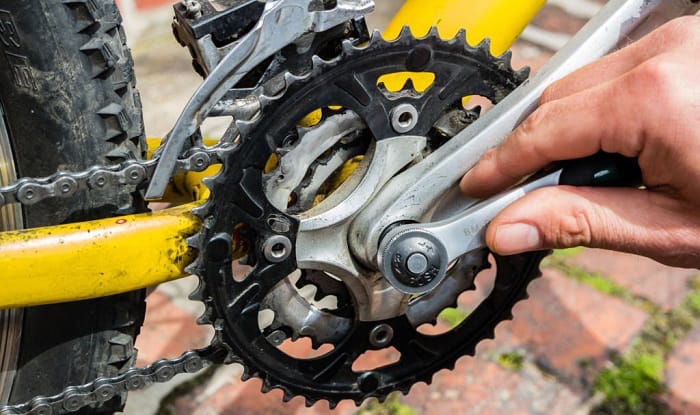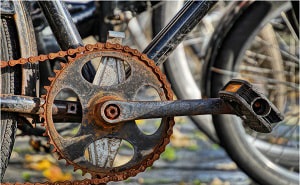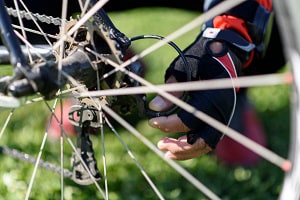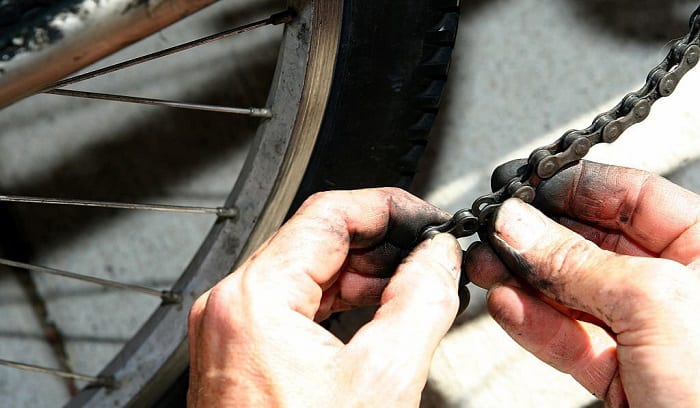Anyone who has been cycling long enough will probably ask one question at some point, “why does my bike chain keep falling off?” If you’ve been there yourself, fear not; this is a problem that is as easy to identify as it is to fix.
A worn-out or even dirty chain may be to blame, but there are many other reasons why a bike chain keeps coming off. Here are some of the most likely reasons for such a cycling problem.
Keep reading to find out more.
Table of Contents
Bike Chain Falling Off – The Common Causes
A situation where the bike chain fell off is normal, whether it’s on a mountain bike or a dirt bike. However, it becomes a problem if it is a frequent occurrence and needs to be addressed.
Take a look at some of the causes for this.
1. Dirty or clogged chain
A dirty chain may become clogged, leading to losing its grip on the cassette. When this happens, it may lead to the chain slipping on bike.
The solution is to clean the chain with a cleaner and degreaser to clear the links of grime.
Performing regular maintenance on your bike is usually enough to keep this problem from happening. Ideally, chains should be cleaned after every ride.
2. The chain is worn-out, damaged, or too long
If the chain keeps falling off bike even after cleaning, it may be worn out or damaged.
Such damage includes bending from a bump on the road, rusting, or deterioration from poor storage or transportation. Even a new bike can end up with such problems.
Frequent falling off may also happen when the chain is too long, and this is often the case when the bike is newly fitted. Adjusting the length by removing excess links should address the problem.
However, it’s not only newly fitted chains that may be too long as even properly fitted ones can become so due to stretching.
Use a wear indicator tool to see if a replacement is necessary. If the chain is worn out, you can only replace it, but if it’s just a bend or specific link that’s the problem, you can just take it out and replace the affected link.
3. Stiff links
When the links are stiff, whether there are many of them or just one, the movement of the chain won’t be smooth, which can lead to skipping or the chain falling off. This can happen whether you’re biking normally or when pedaling backwards.
Stiff links can be the result of different things such as rusting. It can also come from an improperly adjusted chain pin, so it’s important to examine closely.
Lube the chain to try to loosen stiff links. You can also make use of a chain tool to make small adjustments to the pin.
4. Worn-out gears
Worn-out gears can also lead to a situation where the chain keeps coming off bike. This type of wear occurs from long periods of use due to the frequent movement of the chain, especially during shifting.
The gear teeth usually bear the brunt of such damage, and the only solution is to have the cassette replaced.
5. Misaligned or damaged derailleur
The derailleur is a mechanism on the bike that guides the chain and controls its tension; a bike can have two, a front and rear one. They are what keep the chain in proper alignment, and any damage to these parts can cause the chain to fall off.
A misaligned derailleur can also cause the same problem but is usually fixable by adjusting the tightness of its two screws. Issues may also occur if the front and rear derailleurs on a bike are not in line with one another.
You can tell when there is misalignment as the sound from shifting is noisier when the derailleur is in such a state.
6. Cross chaining
Cross chaining happens when the front and rear sprockets are at the same extreme gear settings. This applies when they are both at the largest or smallest gears.
The chain falling off is more commonly associated with going large for both sprockets and happens when trying to shift down on the front gear.
It is a common problem because going all big is something that many beginners find themselves doing unconsciously when pedaling hard.
The obvious solution is to know how to shift better, but this is easier said than done as even experienced bikers find themselves cross-chaining once in a while.
Fortunately, modern bikes are designed to be able to withstand problems that may arise from cross chaining, but only if it does not happen too often and everything is set up correctly.
As for a shifting solution, it helps to know how to deal with it should you find yourself in such a situation. Shift down on the small rear gears first before the front ones; this will help prevent the bike chain slipping on front sprocket.
Frequently Asked Questions
1. How long do bike chains last?
We measure the lifespan of chains based on wear and not on the length of time they are used. Many people use mileage as a measurement, with 500 to 5000 miles an acceptable standard.
This is a wide range because it changes depending on many factors, such as the terrain and bike type.
A good and reliable way to determine if a replacement is in order is to check using a chain wear indicator. If the tool’s teeth slip into the links, it’s time to change it.
2. What do you need to disconnect a chain?
It is necessary to disengage the chain link to shorten it. For standard chains, a chain tool is needed to break and reconnect the link, although this is not always the case.
Some chains have master links or quick links that can be more easily removed even without a tool, but having pliers will make the process easier.
Conclusion
You no longer need to ask “why does my bike chain keep falling off?” after reading this article. With what we’ve covered, you have a better idea of how this problem comes about and what things to do to try to resolve it.
Do you have any bike chain-related experiences you’d like to share? Maybe others can learn a thing or two from you as well. Tell us all about it in the comments section below.
Always ride safely.

“I ride my bike to work for years, but is that enough? Our carelessness towards our surroundings has taken a toll on the environment. And now, everyone is responsible for changes; even the most minor contribution is counted. With this hope and spirit, I started with my partner to establish Biketoworkday to help more individuals commute to their work sites on their bikes.”






